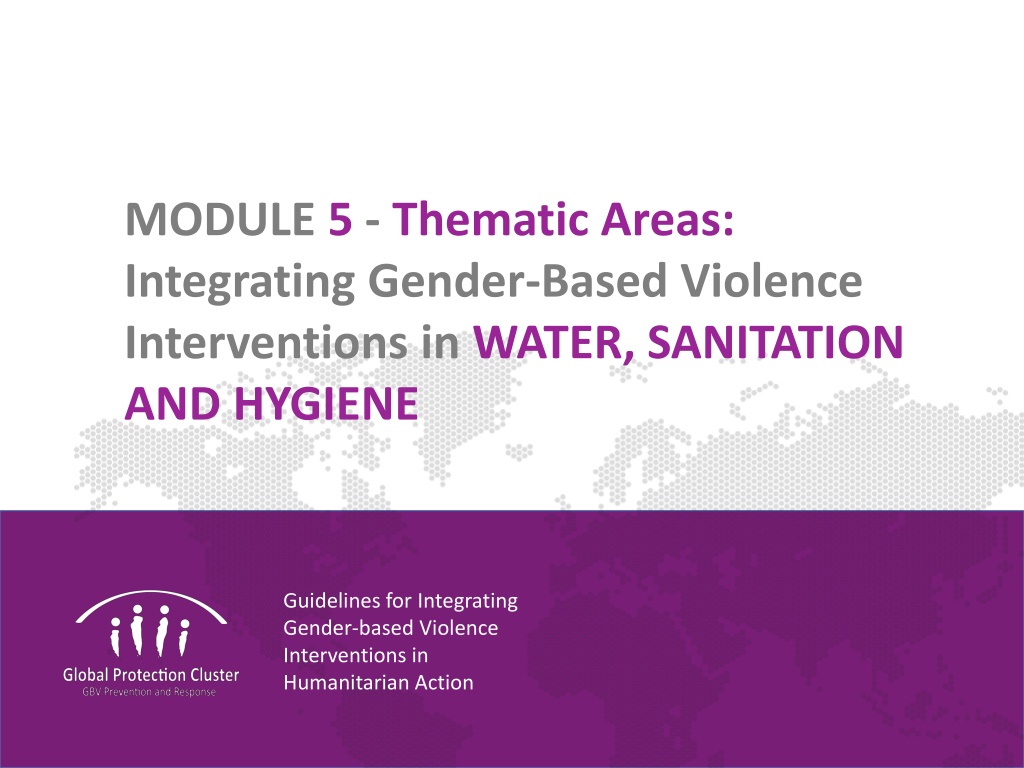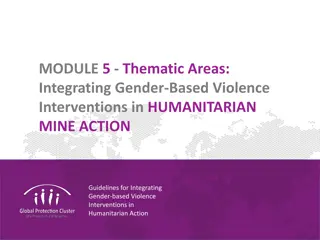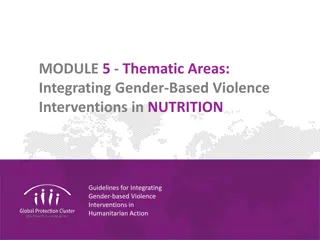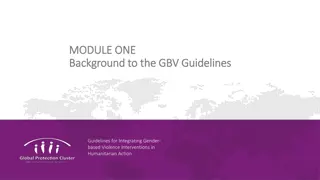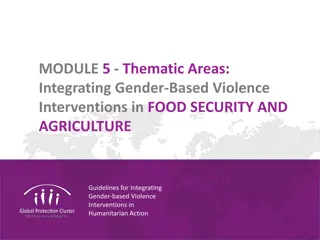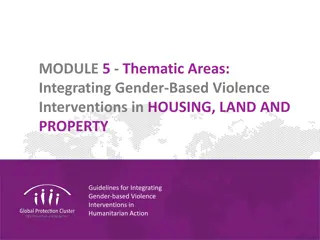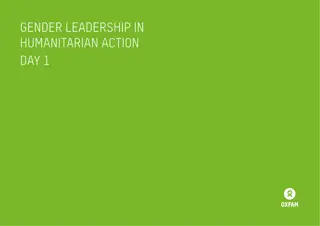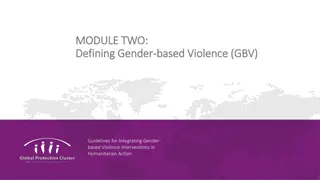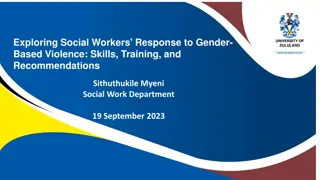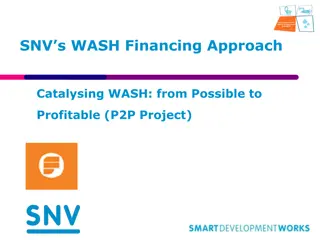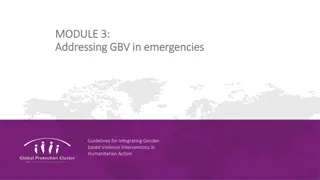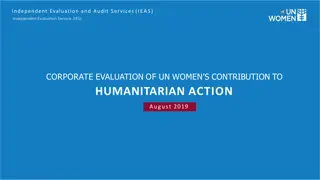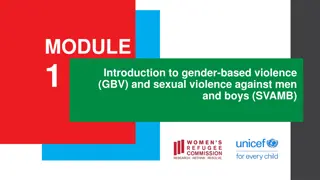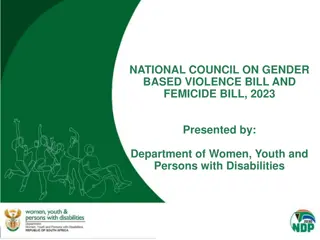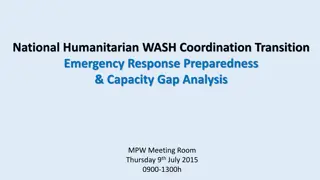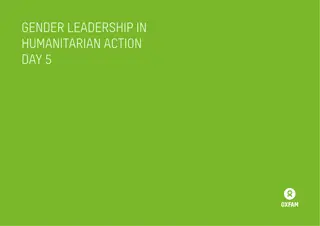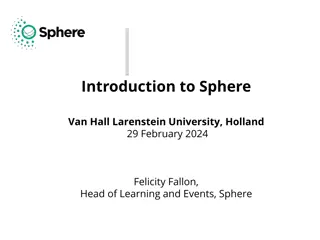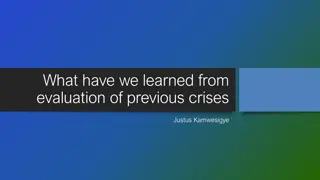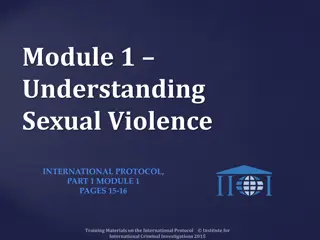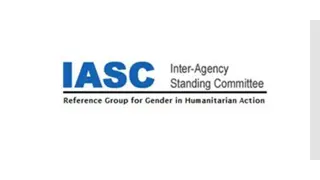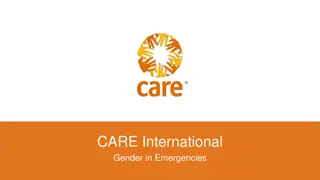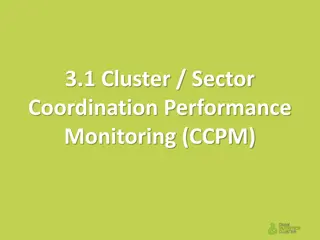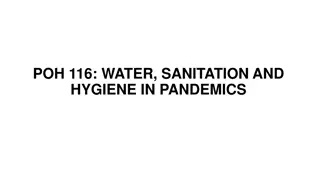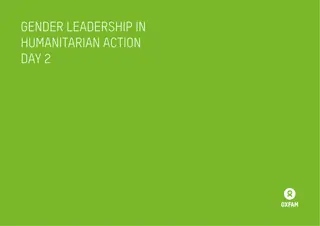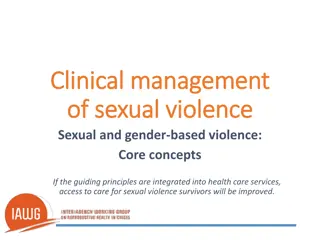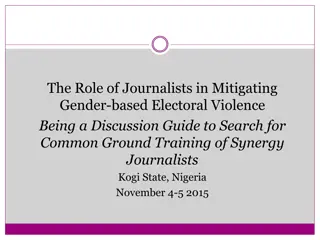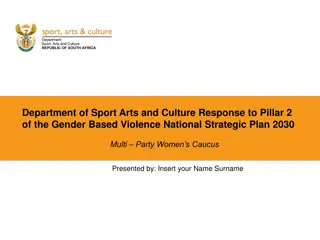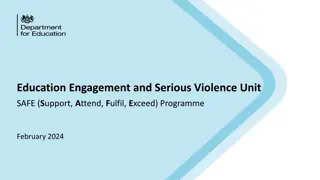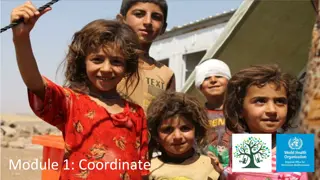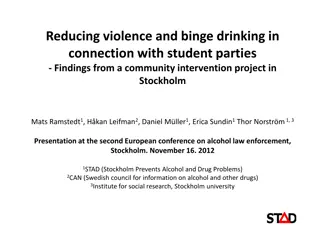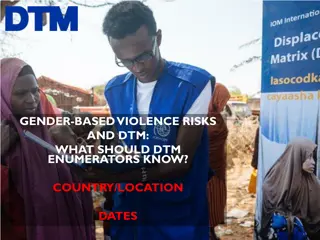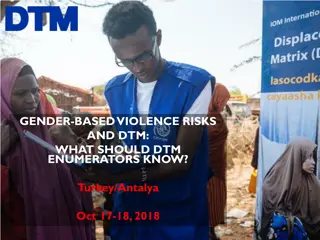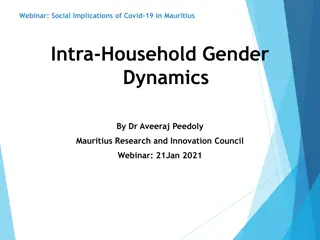Integrating Gender-Based Violence Interventions in WASH Humanitarian Action
This module focuses on guidelines for integrating gender-based violence interventions in water, sanitation, and hygiene (WASH) within humanitarian action. It covers key areas such as agenda links, outcomes, protection measures, risk mapping, assessment, and planning for addressing gender-based violence risks in WASH settings.
Download Presentation

Please find below an Image/Link to download the presentation.
The content on the website is provided AS IS for your information and personal use only. It may not be sold, licensed, or shared on other websites without obtaining consent from the author. Download presentation by click this link. If you encounter any issues during the download, it is possible that the publisher has removed the file from their server.
E N D
Presentation Transcript
MODULE 5 - Thematic Areas: Integrating Gender-Based Violence Interventions in WATER, SANITATION AND HYGIENE Guidelines for Integrating Gender-based Violence Interventions in Humanitarian Action
Agenda Links between GBV and Humanitarian Programming Knowledge Basics for Implementing the Thematic Area Guidance A Closer Look: Assessment; Resource Mobilization; Implementation; Referrals; Coordination; Monitoring and Evaluation Discussion of Implementation Strategy Developing an Action Plan
Outcomes WATER, SANITATION AND HYGIENE actors are informed about key relevant elements of the Guidelines WATER, SANITATION AND HYGIENE actors are supported to develop an action plan with indicators for integrating the Guidelines recommendations into their areas of operation WATER, SANITATION AND HYGIENE actors identify accountability measures to track progress of GBV risk reduction mainstreaming and response WATER, SANITATION AND HYGIENE (WASH)
Protection of all persons affected and at risk must inform humanitarian decision- making and response it must be central to our preparedness efforts, as part of immediate and life-saving activities . Guidelines for Integrating Gender-based Violence Interventions in Humanitarian Action
Warm-up Activity: Mapping Risk across WASH 1) What types of GBV are prevalent in your settings? 2) What are the risks in this setting that contribute to GBV Pre-existing - exists independent of, or prior to emergency or conflict (culture, policy, etc.) Emergency-related - specific to/resulting from the disaster or conflict Humanitarian-related - caused directly or indirectly by humanitarian environment 3) What can your cluster/sector do to prevent and mitigate GBV risks? Pre-existing risk mitigation activity Emergency-related risk mitigation activity Humanitarian-related risk mitigation activity Guidelines for Integrating Gender-based Violence Interventions in Humanitarian Action
Assessment, Analysis and Planning What are our priority areas of inquiry for WATER, SANITATION AND HYGIENE?
A walk through WASH TAG: Assessment, Analysis & Planning Key point: Purpose is not for WASH actors to undertake standalone GBV assessments, but rather to incorporate questions related to GBV risks into their ongoing WASH assessments Guidelines for Integrating Gender-based Violence Interventions in Humanitarian Action
A walk through WASH TAG: Assessment (cont d) Provides a list of recommended GBV-related questions to incorporate, as relevant, into WASH assessments and routine monitoring These questions do not cover the nature and scope of GBV, but basic issues related to WASH programming, policies and communications WASH specialists are NOT expected to undertake assessments about the extent of GBV Guidelines for Integrating Gender-based Violence Interventions in Humanitarian Action
What does this mean for WASH ? From page 42: e) What are the preferences and cultural habits to consider before determining the type of toilets, bathing facilities, laundry, kitchens and water points to be constructed? l) Are WASH facilities secure? (sufficient lighting, adequate privacy, locks from inside, etc.) Guidelines for Integrating Gender-based Violence Interventions in Humanitarian Action
Activity: Conducting Assessments Option 1: Review and Discuss Review the Areas of Inquiry in the GBV guidelines: 1) Which questions would you prioritize? 1) How will you collect this information? I. What surveys / assessment are already being used where you can integrate questions II. When and where will the survey occur to ensure participation of at-risk groups 3) Who would you need to work with to collect this information? I. What is the composition of the assessment team, men / women? II. What training will they require? III. How will they communicate about the assessment with the community? Guidelines for Integrating Gender-based Violence Interventions in Humanitarian Action
Activity: Conducting Assessments Option 2: Review and Compare Review the Areas of Inquiry in the GBV guidelines against your current assessment tool. 1) Which GBV risks and considerations are already integrated in the assessment tool currently or previously used? 1) Which GBV risks or considerations would you prioritize for inclusion? 2) How will it be possible to integrate new questions which consider GBV risks? I. With whom will you need to advocate to include these areas of inquiry? - Cluster coordinators, state actors, GBV specialists II. With whom will you need to collaborate in order to safely and effectively integrate these areas of inquiry? - Cluster coordinators, state actors, GBV specialists Guidelines for Integrating Gender-based Violence Interventions in Humanitarian Action
Activity: Conducting Assessments Option 3: Mapping information on GBV risks to mitigation Prioritize 3 areas of inquiry that apply to your context and carry out the below: Area of Inquiry Risk of Concern Potential for GBV Mitigation 1. Cultural and community norms and practices WASH facilities are unsafe or unfit for specific cultural needs (sit versus squat toilet) and vulnerabilities (lack of privacy) Harassment, violence around and in WASH facilities, violence against women traveling far to defecate outdoors Design WASH facilities considering specific risks (location, lighting, inclusion), maintenance, specific needs (showers for intersex/transsexual). Engage women and girls in the development of WASH policies, standards and guidelines. 2. Infrastructure Drop-off points, distance to facilities, improper safety mechanisms restrict access to WASH, jeopardize hygiene, health Harassment and assault, rape, intimate partner violence Guidelines for Integrating Gender-based Violence Interventions in Humanitarian Action
Quiz: Conducting Assessments WASH actors should: Consult GBV specialists throughout the planning, design, analysis and interpretation of an assessment Not use local expertise Strictly adhere to safe and ethical recommendations for researching GBV Share data that may be linked back to a group or an individual, including GBV survivors Seek out GBV survivors to speak to them specifically about their experiences of GBV Guidelines for Integrating Gender-based Violence Interventions in Humanitarian Action
Quiz: Conducting Assessments Assume reported data on GBV/trends represent actual prevalence/trends in the extent of GBV Include GBV specialists on inter-agency and inter-sectoral teams Not include female assessors and translators when conducting assessments Conduct consultations in a secure setting where individuals feel safe to provide information and participate in discussions and decision-making Provide training for assessment team members on ethical and safety issues Guidelines for Integrating Gender-based Violence Interventions in Humanitarian Action
Discussion: Is it always possible to include GBV in initial assessments? How can one ensure inclusion of at-risk groups in assessments? Who needs to be involved? Why is it the responsibility of WASH staff? Where does this responsibility ends? Who needs to be convinced? ALWAYS INVOLVED WOMEN AND OTHER AT- RISK GROUPS IN THE DESIGN AND ASSESSMENT OF WASH PROGRAMS Guidelines for Integrating Gender-based Violence Interventions in Humanitarian Action
Resource Mobilization What are WATER, SANITATION AND HYGIENE commitments to Resource Mobilization for GBV risk reduction?
A walk through the WASH TAG: Resource Mobilization Key point: Funding for WASH-related GBV prevention and risk mitigation activities must be included in project proposals from the outset of emergency response Guidelines for Integrating Gender-based Violence Interventions in Humanitarian Action
A walk through the WASH TAG: Resource Mobilization In humanitarian settings, GBV resources tend to be linked to longer-term protection and stability initiatives Resources to address GBV in emergencies are often limited The Guidelines provide recommendations on incorporating GBV risk mitigation activities into project proposals Donors are encouraged to reference this section to ensure GBV issues are included in WASH proposals Guidelines for Integrating Gender-based Violence Interventions in Humanitarian Action
A walk through the WASH TAG: Resource Mobilization GBV risk based on gender analysis and safety audit Proposed intervention Risk vs. benefits Adapted intervention Impact? Guidelines for Integrating Gender-based Violence Interventions in Humanitarian Action
What does this mean for WASH ? GBV-related points to consider for inclusion in a proposal (Pg.46): 1). Humanitarian Needs Overview/Situation Analysis: Describe the vulnerabilities of women, girls and other at-risk groups; 2). Project Rationale/Justification: Explain GBV-related risks related to WASH interventions in your context; 3). Project Description: Explain which activities may help in preventing or mitigating GBV Describe mechanisms that facilitate reporting of GBV in safe and ethical manner Guidelines for Integrating Gender-based Violence Interventions in Humanitarian Action
What does this mean for WASH ? How to measure GBV-related points to consider for inclusion in a proposal, cont d: Monitoring and Evaluation: M&E plan should track progress and adverse effects on GBV mainstreaming activities; M&E plan should include the participation of women, girls and other at- risk groups; Include outcome-level indicators to measure program impact on GBV- related risks; Disaggregate indicators by sex, age, disability and other vulnerability factors Guidelines for Integrating Gender-based Violence Interventions in Humanitarian Action
THE IASC GENDER MARKER Both Gender marker and GBV mainstreaming address issues of women and girls empowerment and gender equality and include men and boys as partners in prevention. = Tool that codes (0-2 scale) whether or not a humanitarian project is designed well enough to ensure that women/girls, men/boys will benefit equally from it or that it will advance gender equality in another way Guidelines for Integrating Gender-based Violence Interventions in Humanitarian Action
What does this mean for WASH ? Some examples of GBV mainstreaming activities that can be included in proposals: Sanitation facilities are designed and built based on universal design and/or reasonable accommodation2 to ensure accessibility for all persons, including those with disabilities Sanitary supplies and hygiene materials are appropriate to distribute to women and girls, especially related to menstruation Guidelines for Integrating Gender-based Violence Interventions in Humanitarian Action
What does this mean for WASH ? Do you have other examples of mitigation strategies? Guidelines for Integrating Gender-based Violence Interventions in Humanitarian Action
Activity: Resource Mobilization In Small Groups: Review the assigned proposal in line with the resource mobilization checklist of the Guidelines and highlight: Good practices Gaps Proposed strategies to address these gaps. Tools needed to better design proposals Guidelines for Integrating Gender-based Violence Interventions in Humanitarian Action
Discussion: Is GBV-related activities in WASH programs always cost-effective? Why should it be considered? Do donors always support GBV-related activities in WASH programs? What can be some of these barriers? GBV MAINSTREAMING ACTIVITIES ALWAYS CONTRIBUTE TO GOOD WASH PROGRAMMING Guidelines for Integrating Gender-based Violence Interventions in Humanitarian Action
Implementation What are our commitments to include GBV prevention and mitigation within ongoing and new WATER, SANITATION AND HYGIENE activities?
A walk through the WASH TAG: Implementation Key takeaway: If effectively designed, WASH programmes can mitigate risks of GBV: Safe access to facilities Participation of women and girls in WASH committees Supporting privacy and dignity Guidelines for Integrating Gender-based Violence Interventions in Humanitarian Action
A walk through the WASH TAG: Implementation Provides guidance for putting GBV-related risk reduction responsibilities into practice Activities to improve the overall quality of GBV-related prevention and mitigation strategies: Establish GBV-related responsibilities common to all actors working within WASH Recommend strategies for WASH actors to reduce risks Maximize immediate protection of GBV survivors and persons at risk and foster longer-term interventions to eliminate GBV 3 main types of responsibilities: programming, policies, and communications & information sharing Guidelines for Integrating Gender-based Violence Interventions in Humanitarian Action
What does this mean for WASH? From pages 47: Ensure handpumps and water containers are women- and girl-friendly, and are designed in ways that minimize the time spent collecting water. Build upon indigenous knowledge and practices to construct age-, gender-, and culturally sensitive WASH facilities (including toilets, laundry, kitchen and bathing facilities). Guidelines for Integrating Gender-based Violence Interventions in Humanitarian Action
Activity- Implementation Option 1: Review Mitigation Strategies In small groups: 1. Review recommended mitigation strategies 2. Add any strategies missing 3. Prioritize 2-3 key strategies that should be prioritized 4. Highlight operational challenges Rotate teams: troubleshoot challenges, provide recommendations 5. Create operational action plan: i. Key actions ii. Coordination amongst key actors iii. Resources / support required Guidelines for Integrating Gender-based Violence Interventions in Humanitarian Action
Activity- Implementation Option 2: Mitigating GBV risk in Program Strategy Review current programmatic strategy In small groups: 1. 2. 3. 4. Highlight GBV mitigation strategies currently integrated Review Guideline recommended mitigation strategies Prioritize 2-3 key strategies that should be prioritized Create operational action plan: i. ii. iii. iv. Information needed Key actions Coordination amongst key actors Resources / support required Guidelines for Integrating Gender-based Violence Interventions in Humanitarian Action
Discussion: Prioritization and Selection Criteria How to prioritize GBV risk reduction in WASH programs? What types of investments are required? What vulnerability criteria would you use? What challenges are associated with these? How should sensitive information be managed to protect affected populations, including survivors of GBV? DON T SINGLE OUT GBV SURVIVORS OR VULNERABLE GROUPS 33
Coordination What are our commitments to include GBV prevention and mitigation within ongoing and new WATER, SANITATION AND HYGIENE activities?
A walk through the WASH TAG: Coordination Key takeaways: GBV prevention and risk reduction is most effective when done in coordination with both GBV specialists and other sectors Recommends specific actions for WASH actors to coordinate with others Guidelines for Integrating Gender-based Violence Interventions in Humanitarian Action
A walk through the WASH TAG: Coordination Supports humanitarian actors to define responsibilities and accountability mechanisms in GBV prevention and response efforts Establish responsibilities for humanitarian actors in the prevention and mitigation of GBV Maximize immediate protection of GBV survivors and persons at risk through multi-sectoral coordination on response to GBV incidents Coordination activities can move across the 3 main types of responsibilities: programming, policies, and communications & information sharing and may also include advocacy / efforts for: Assessment Resource Mobilization Monitoring and Evaluation Guidelines for Integrating Gender-based Violence Interventions in Humanitarian Action
A walk through the WASH TAG: Coordination (Pg.53) GBV Specialists can assist WASH actors to: 1. Design and conduct WASH assessments that examine the risks of GBV, and strategize ways to mitigate these risks Provide trainings for WASH staff on issues of gender, GBV and women s/human rights Develop standard operating procedures (SOPs) for security sector actors 2. 3. Guidelines for Integrating Gender-based Violence Interventions in Humanitarian Action
What does this mean for WASH? Coordinationwith GBV Specialists, cont d GBV Specialists can assist WASH actors to: 4. Identify where survivors can receive care, and provide WASH staff with skills and information to respond supportively to survivors Provide training for the affected community on issues of gender, GBV and women s/human rights as they relate to WASH rights Review relevant statutory and customary laws and policies to strengthen GBV-related legal protections 5. 6. Guidelines for Integrating Gender-based Violence Interventions in Humanitarian Action
What does this mean for WASH: Coordination with other sectors (p. 55) WASH actors can work with (for example): CCCM actors to provide WASH measures for persons and groups at risk of GBV Child protection actors to build the capacity of law enforcement actors to respond to the needs of child survivors Guidelines for Integrating Gender-based Violence Interventions in Humanitarian Action
What does this mean for WASH: Coordination for cross-cutting issues Also coordinate with partners addressing: gender mental health and psychosocial support (MHPSS) HIV age environment Guidelines for Integrating Gender-based Violence Interventions in Humanitarian Action
Activity: Coordination Option 1: Mechanisms to Support Program Implementation Return to small groups from the implementation activity: 1. 2. Reflect on the specific actions recommended Who needs to be involved to execute this action GBV specialists Other clusters What type of coordination is required be specific - Roles and responsibilities - Accountability mechanisms 3. Guidelines for Integrating Gender-based Violence Interventions in Humanitarian Action
Activity: Coordination Mapping With what sectors would WASH benefit from stronger coordination? i. ii. iii. iv. What coordination mechanisms exist to support collaboration Key actions Who is responsible, accountable, needs to be informed How will you monitor progress How could WASH and protection actors better coordinate/work together? i. What coordination mechanisms exist to support collaboration ii. Key actions iii. Who is responsible, accountable, needs to be informed iv. How will you monitor progress Guidelines for Integrating Gender-based Violence Interventions in Humanitarian Action
Suggested recommendations about referrals in the Guidelines All humanitarian personnel who engage with affected populations should have up to date written information about where to refer survivors for care and support. Ensure training on how to respectfully and supportively engage with survivors and provide risk reporting and/or referral information in an ethical, safe and confidential manner Any programmes that share information about reports of GBV must abide by safety and ethical standards (e.g. shared information does not reveal the identity of or pose a security risk to individual survivors, their families or the broader community) Guidelines for Integrating Gender-based Violence Interventions in Humanitarian Action
Activity: Coordination Option 3: Coordination and Referrals w/ GBV specialists In small groups discuss: Map the current referral mechanism where your activities are ongoing - What services are available - Which actors are involved What are your responsibilities within the referral mechanism? - Who do you immediately report an incident to? - Are there cases where you are unable to refer? What happens when there is no referral mechanism in place or when it is not functioning? - What are your responsibilities in this situation? Guidelines for Integrating Gender-based Violence Interventions in Humanitarian Action
Monitoring and Evaluation What are priority indicators for GBV prevention and risk mitigation in WATER, SANITATION AND HYGIENE programming?
A walk through the WASH TAG: Monitoring & Evaluation Key Point: Indicators can be used to measure the outcomes of activities undertaken across the programme cycle, with the ultimate aim of maintaining effective programmes and improving accountability Guidelines for Integrating Gender-based Violence Interventions in Humanitarian Action
A walk through the WASH TAG: Monitoring & Evaluation Why? Limited evidence exists on effective integration of GBV programming in other sectors Indicators in the Guidelines aim to: Track outputs resulting from interventions to affected populations Chart outcome of cluster activities Measure progress toward objectives, considering diversity of affected populations & their perspectives of the response Guidelines for Integrating Gender-based Violence Interventions in Humanitarian Action
Monitoring & Evaluation: Indicators Why? Limited evidence exists on effective integration of GBV programming in other sectors Indicators in the Guidelines aim to: Track outputs resulting from interventions to affected populations Chart outcome of cluster activities Measure progress toward objectives, considering diversity of affected populations & their perspectives of the response Guidelines for Integrating Gender-based Violence Interventions in Humanitarian Action
A walk through the WASH TAG: Monitoring & Evaluation: Reporting Analyze existing data using a GBV lens to improve GBV prevention and response Example: Existence of female WASH staff during assessments What are the implications of the findings? How may this affect GBV prevention and mitigation? Failing to meet a target can lead to response and resource mobilization Use data for action across the programme cycle! Guidelines for Integrating Gender-based Violence Interventions in Humanitarian Action
What does this mean for WASH? # of WASH assessments that include GBV-related questions # of humanitarian WASH personnel who are female during the assessment # of WASH funding proposals or strategies that include at least one GBV risk-reduction objective, activity or indicator # of registration sites that include GBV as a risk factor for vulnerability # of WASH community outreach activities that include information on where to report risk and where to access care for GBV survivors Guidelines for Integrating Gender-based Violence Interventions in Humanitarian Action
